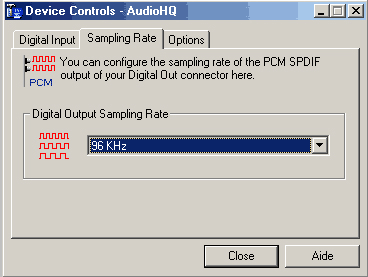Big Sound, Low Price: Creative Audigy
Sampling

The Audigy is, above all, the first Creative soundcard capable of sampling not only at 16 bits at 44.1 kHz, the format on which audio CD is based, but also at higher definition, with 24 bits at 48 kHz. On paper, the dynamic gain is obvious, because the music is digitized using a much finer grid. But even at 24 bits, the quality of an audio file is always dependent on the recording conditions. In practice, the preamplifiers and the converters have a big effect on the quality of sound above 16 bits, and only a 24 bit recording made under studio conditions will get the best from the format. It is obvious that all applications will very soon change to this format to gain in dynamics. But for the moment, the digital inputs on the Audigy card are the most appropriate use for it, while transferring, for example, high-definition files for digital editing on the computer. On the other hand, a mini disc recording at 24 bits, in the 16 bit compressed format, will not achieve anything; indeed, quite on the contrary, it would be necessary to go through an analog step, which would risk adding hiss. The card's converters can work precisely at 16 bits and at 24 bits, at a great number of frequencies: 11.025, 22.050, 32, 44.1 and 48 kHz in analog, and up to 96 kHz in digital. Our test with Cubase allowed us to check the two resolutions (16 and 24 bits), as well as the first five frequencies, with the appropriate driver. However, 96 kHz does not appear in the software. On the other hand, sending a 24/96 signal via the S/PDIF input did not produce any result with the drivers at our disposal. Moreover, for 96 kHz, Creative only mentions the possibility of a passthrough.
Cubase recognized three types of driver: ASIO Multimedia, ASIO Direct X Full Duplex, and ASIO Emu 10K. Depending on the driver, the card's response time varies quite a bit, and settles down in each case with a frequency of 44.1 kHz at 750 ms (three quarters of a second, an eternity) 46 ms (much better, but still a little slow) and from 500 ms to 2 ms with the ASIO driver (but only at 48 kHz). The source selection of the audio clock, which has to be switched to the S/PDIF input to allow the acquisition of a digital signal, is not accessible using Cubase. The only reference we found concerns the digital frequency of the output and is controlled using the "Device Control" window of the Audio HQ.
Stay on the Cutting Edge
Join the experts who read Tom's Hardware for the inside track on enthusiast PC tech news — and have for over 25 years. We'll send breaking news and in-depth reviews of CPUs, GPUs, AI, maker hardware and more straight to your inbox.
Most Popular

